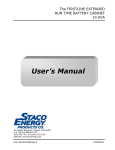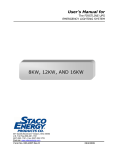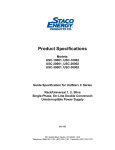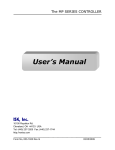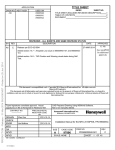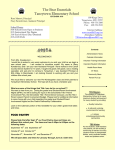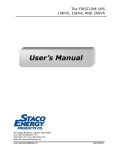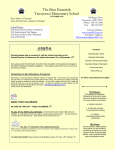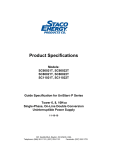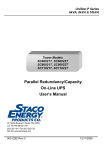Download TreStar 924 Product Specification
Transcript
Product Specifications Guide Specification for FirstLine® 924 8kW, 12kW, 16kW Three-Phase Emergency Lighting Uninterruptible Power System 5/15/10 301 Gaddis Blvd, Dayton, OH 45403, USA Telephone: (866) 261-1191, (937) 253-1191 Facsimile: (937) 253-1723 SECTION 1.0 SCOPE AND SYSTEMS RATING 1.1 Specification This Specification defines the electrical and mechanical characteristics and requirements for a continuous duty, three phase, uninterruptible power system. This system shall utilize "true on-line" transistor based pulse width modulated (PWM) inverter incorporating Isolated Gate Bipolar Transistor (IGBT) technology. The inverter is a microprocessor controlled, solid-state device within the uninterruptible power system. The uninterruptible power system, hereafter referred to as the UPS, shall provide high quality AC power for sensitive electronic equipment loads. The UPS shall consist of a rectifier/charger, battery, inverter, protective devices, static transfer switch, synchronizing and phase lock circuitry, and controls required to provide regulated, uninterrupted, conditioned power to the critical load. The UPS shall include all mechanical and electrical devices that will automatically provide continuity of electrical power within the defined limits without interruption upon failure or degradation of the commercial power source. Continuity of conditioned electric power shall be maintained for the defined period of time by the battery system. Upon return of the utility power source, the UPS shall automatically assume the load, while simultaneously recharging the batteries. 1.2 Modes of Operation The UPS shall be designed to operate as an on-line reverse transfer system in the following modes: 1.2.1 Normal The critical AC load is supplied continuously by the inverter. The rectifier/charger derives power from a utility AC source and supplies DC power to the inverter while simultaneously float charging a battery system. The inverter converts the DC power into clean and regulated AC power that is then supplied to the critical load through the static transfer switch. 1.2.2 Emergency Upon failure or degradation of the utility AC power, the critical AC load supplied by the inverter will draw its power from the batteries. There shall be no interruption of power switching from utility AC power to batteries or while switching from batteries back to utility AC power upon its restoration. 1.2.3 Recharge Upon restoration of utility AC power, even if the batteries are completely discharged, the UPS will restart. The rectifier/charger shall "walk-in" and gradually assume the inverter and battery recharge loads. If the bypass source is within acceptable limits, the UPS will retransfer the critical load back to the inverter. 1.2.4 Bypass When the inverter overload capacity is exceeded, the static transfer switch shall perform a transfer of the load from the inverter to the bypass source with no interruption in power to the critical load. FirstLine 924 Guide Specification Pg. 2 8-16 kW 1.2.5 Maintenance Bypass If for some reason the UPS has to be taken out of service for maintenance or repair, the UPS shall be provided with an external maintenance bypass switch to enable a load transfer from the inverter to the bypass source with no interruption of power to the critical load. Bypass isolation shall be complete, all serviceable components are to be isolated: i.e. over-current protective devices, rectifier, inverter, static switch and transformers. 1.3 System Ratings 1.3.1 UPS Unit Input / Output Voltages: Specification for the UPS shall be: Primary Input: 208/120Vac, 220127Vac, 480/277Vac Wye, three-phase, 4-wire (plus ground); within +/-10% for system start. UPS Output: 208, 220, 480Vac wye, three-phase. Primary Input: 208 volts, three phase, (plus ground) UPS Output: 208 volts, three phase, (plus ground) or Optional: Input with Delta 3-wire + ground requirements shall have: Internal* mounted K-20 rated Isolation Transformer to provide 480 VAC, 208VAC or 220 VAC, three phase, 4- wire (no neutral). *Systems that require an external make-before-break 3 breaker maintenance bypass switch with difference input/output voltages (4 x 2), the Isolation Transformer shall be mounted internal of the Option Cabinet with the MBPS 1.3.1.2 Input / Output Load Rating: Specification for the UPS shall be 10Kva /8kw 15Kva/12kw 20Kva/16kw KVA 10, 15, 20Kva 10, 15, 20Kva 10, 15, 20kva 10, 15, 20kva FirstLine 924 Guide Specification Vac In/Out 208/208 220/220 480/208 480/480 Pg. 3 8-16 kW 1.3.2 Battery The battery shall be of the valve regulated lead acid type, comprised of enough multi-cell batteries to meet the DC voltage levels of the UPS. 1.3.2.1 Battery Cabinet The battery cabinet shall be constructed of the same materials used in the UPS cabinetry and shall be of the “line-up-and-match” type. The battery cabinet shall include slide-out shelves for mounting of the batteries and to provide access for ease of maintenance. A fuse will be utilized for short-circuit protection. SECTION 2.0 GENERAL REQUIREMENTS 2.1 System Description 2.1.1 Rectifier/Charger 2.1.1.1 Input Protective Devices The rectifier/charger shall include protection against primary power surges, (except for lightning transients) and under or over voltage conditions. 2.1.1.2 Filtering Sufficient filtering of the rectifier/charger output shall be provided to prevent damage to the battery. Ripple voltage shall not exceed 2% RMS. Voltage variation shall not exceed 1% at any load condition 0 -100%. 2.1.1.3 In-Rush Limiting The rectifier/charger shall be equipped with a "walk-in" feature. When the primary power is applied to the rectifier/charger, the current surge shall be limited to 25% of the full rated output current and shall gradually increase to full load rating within 10 seconds. 2.1.1.4 Rectifier/Charger Capacity The rectifier/charger shall have sufficient capacity to supply full load current to the inverter while recharging a fully discharged battery. Battery charge current shall be limited to 6 amps maximum output current at any UPS load condition, at nominal input voltage. 2.1.2 Inverter The inverter section of the power converter module shall be capable of accepting the output of the rectifier/charger or the battery system voltage and delivering AC power within specified limits to the critical load bus. The inverter shall be microprocessor controlled and shall include all necessary timing logic and control circuits. 2.1.2.1 Inverter Start-Up The inverter shall automatically startup when a start command is generated and shall be stable and ready to deliver power to the load within 5 seconds. 2.1.2.2. Inverter Protection Inverter shall be protected by current limiting circuits. The inverter shall be capable of running indefinitely with the batteries disconnected. For rapid removal of the inverter from the critical load, the inverter control electronics shall instantaneously turn off the inverter when the inverter‟s capacity is exceeded. FirstLine 924 Guide Specification Pg. 4 8-16 kW Simultaneously, the static transfer switch shall transfer the load to utility power without interruption to maintain continuous power to the critical load. 2.1.2.3. Inverter The inverter shall be capable of operating and maintaining the output frequency of the inverter within specified limits. The inverter shall be capable of frequency synchronization and phase locking to the utility power source frequency. When the Bypass source is not qualified, or a failure occurs the inverter shall automatically revert to a free running state and maintain the specified limits. The inverter shall not drift more than 0.1% while operating at maximum rated operating temperature. 2.1.2.4 Inverter DC Protection The inverter shall be automatically protected at the following DC voltage levels, which shall be independently adjustable for UPS application flexibility. DC Over voltage Shutdown = 2.40 V/cell DC Under voltage Shutdown = 1.75 V/cell 2.1.2.5 Phase Balance The inverter shall operate with a 100% load imbalance phase to phase. 2.1.3 Static Transfer Switch An internally mounted static transfer switch, and bypass circuit shall be provided as an integral part of the UPS. The static switch shall be naturally commutated high speed devices (SCR's) rated to conduct full load current continuously while on inverter or bypass power (reserve source). The reserve portion of the static switch shall be designed to avoid back-feed into the utility supply. Over current protection in the bypass mode will be through fuses. 2.1.3.1 Bypass Transfer The static switch shall automatically and successfully transfer the critical load from the inverter to the bypass source (reserve) under the following conditions: DC voltage out-of-limits failure Inverter failure Critical load current exceeds inverter overload rating Over-temperature develops within the inverter Manual command is given Transfer shall be automatically inhibited, whenever bypass source parameters are outside predetermined (adjustable) limits, or UPS output and bypass are not synchronized and phase locked. 2.1.3.2 Retransfer The static switch shall automatically and successfully retransfer the critical load from the bypass source to the inverter under the following conditions: Inverter output voltage returns to within specified limits. Critical load current reduces to within inverter overload rating. FirstLine 924 Guide Specification Pg. 5 8-16 kW SECTION 3.0 ELECTRICAL SPECIFICATIONS 3.1 Rectifier/Charger Input: a. Nominal Voltage: 208 Vac b. Voltage Limit: +10 / -20% from nominal voltage (-15% for battery recharge) c. Frequency: 57 - 63Hz d. Operation Current Inrush: "Walk-in" from 25% maximum to 100% full load rating in 5 seconds e. Power Factor: 0.95 <7% THD minimum at full load, nominal conditions Output: a. Nominal Voltage: 408 VDC (204 cells - lead acid) "Float" Operation: 2.27 VDC per cell b. Regulation: ± 1% maximum for input voltage and DC variations c. Nominal Current: The rectifier is rated for 25% excess capacity to charge the battery or to achieve full power at low line input. 3.2 Inverter 3.2.1 Power Rating UPS ratings are shown at 0.8 pf lagging, other power factor loads can be supported. 3.2.2 Input Shall operate within specification over the nominal rectifier/charger output range and minimum battery voltage of 1.65 volts per cell. 3.2.3 Output Voltage 208Y VAC-60Hz, 3 Phase, 4 wire (plus ground) 3.2.4 Output Regulation Balanced Loads: Unbalanced Loads: ±1% balanced load - Phase Angle 120 ±1 ±3% 100% unbalanced load - Phase Angle 120o ±3o 3.2.5 Output Waveform Sinusoidal o o 3.2.6 Frequency Stability .01% 3.2.7 Output Dynamic Response Less than 5% voltage change for 100% load step with recovery to less than 2% in less than 1 cycle. FirstLine 924 Guide Specification Pg. 6 8-16 kW 3.2.8 Overload Rating 50% for 30 seconds 125% for 10 minutes 3.2.9 Harmonic Content Linear loads: Max. voltage THD < 2% 100% non-linear load: Max. voltage THD < 5% 3.2.10 Efficiency (AC-AC) Nominal conditions 92% 3.3 Static Transfer Switch 3.3.1 Power Rating Static switch is continuous duty power rated. 3.3.2 Overload Ratings Continuous 125% 1 Minute 175% 30 cycles 250% 5 cycles 700% 3.3.3 Transfer Characteristics Transfer time from inverter: Less than 0.5ms to utility power when both sources are in phase lock, and vice versa. Automatic 5 second delay before allowing retransfer from utility power to inverter after transferring from inverter to utility power. Transfer time from inverter to utility when both sources are not in phase lock: 16 ms (To prevent damage by phase reversal to the load.) SECTION 4.0 GENERAL ELECTRICAL REQUIREMENTS 4.1 Applicable Documents The UPS shall be designed in accordance with the applicable sections of the current revision of the following documents. Where conflict arises between these documents and statements made herein, the statements in this specification shall prevail. UL Standard 924 NEMA PE-1 ASME ASA-C-39.1-1984 FCC PT 15, Subpart J, Class B National Electric Code OSHA IEEE 587 ANSI C 62.41-1980 ISO 9001 FirstLine 924 Guide Specification Pg. 7 8-16 kW 4.2 Wiring Wiring practices, materials and coding shall be in accordance with the requirements of the National Electric Code, NFPA 70 and other applicable codes and standards. The internal neutral sizing of the UPS shall be 1.7 times the line capacity. SECTION 5.0 MECHANICAL STANDARDS 5.1 Cabinet The UPS unit, comprised of the rectifier/charger, inverter, static transfer switch, and shall be housed in a free standing NEMA type 1 enclosure. Cabinet doors and covers shall be removable for expedient servicing, adjustments, and installation. The UPS cabinet shall be structurally adequate, have casters for ease of maintenance and installation and have provisions for forklift handling. The cabinet shall have front and top access for service. 5.2 Material All materials and components making up the UPS shall be new, of current manufacture, and shall not have been in prior service except as required during factory testing. All bus bars shall be copper. 5.3 Thermal Design Forced air-cooling shall be provided to ensure that all components are operated within specification with air entry at the base and exit at the rear. The enclosure shall be mounted with 6 inches of free space at the back for ventilation. 5.4 Serviceability The UPS shall be constructed of replaceable subassemblies. Printed circuit assemblies shall be plug-in. The main control printed circuit and boards shall be interchangeable across the entire product range. 5.5 Finish The UPS and battery cabinets shall be cleaned, primed and painted black. SECTION 6.0 MONITORING AND CONTROLS 6.1 General The UPS unit shall incorporate the necessary controls, instruments and indicators to allow the operator to monitor the system status and performance, as well as take any appropriate action. 6.2 Controls The following minimum operator controls shall be provided. 1. On/Off pushbutton Press for one second to initiate the automatic start sequence of the UPS. When the UPS is running, press and hold the pushbutton for two seconds to stop the UPS. FirstLine 924 Guide Specification Pg. 8 8-16 kW 2. Audible Alarm Silence Cancels internal audible alarm until a new alarm occurs. A LED shall indicate alarm and alarm accepted conditions. 3. Emergency Power off (EPO) Electronically shuts down the rectifier, inverter, static switch and opens the battery switch. 6.3 Mimic Panel The UPS shall have a Mimic Panel with Light Emitting Diodes (LEDs) to indicate the following modes of operation and conditions: Rectifier input not qualified Battery current Summary alarm, rectifier Loss of output voltage Exceeds inverter capacity, will bypass Exceeds bypass capacity, will drop load Off, due to excess load On bypass Phase sequence error Load off Back feed detected 6.4 Display Panel 6.4.1 Controls The front panel shall provide a 4 x 16 LCD display and a mimic panel. The LCD display allows separate displays of 'alarms' and 'system events.' Alarms remain in the log only as long as they exist, while system events continuously accumulate in the system event log until memory is full, whereupon the oldest entries are overwritten by new events. 6.4.2 Rectifier/Battery Alarms Rectifier input not qualified over- or under-voltage or –frequency Battery current < -1.0 A VBus „low Summary of all rectifier alarms Loss of control supply 6.4.3 Inverter Alarms Inverter fault De-saturation of power device, Loss of bus to supervisor DAC failure Heat sink over temperature Loss of control supply Supervisor output voltage (switches to bypass if inverter out of specification) Static switch control, report failure to supervisor Loss of synchronizing Low battery alarm FirstLine 924 Guide Specification Pg. 9 8-16 kW Overload exceeds inverter capacity, will switch to bypass; exceeds bypass capacity and will drop load; turned off due to excess load Static switch control monitors bypass input‟s voltage and frequency Non-volatile storage of system event log 6.4.4 Reserve, Load, Peak Factor On bypass Static switch monitors bypass voltage and frequency Phase sequence error Load off Redundant requirement Back feed detected SECTION 7.0 ENVIRONMENTAL RATINGS 7.1 Ambient Temperature The UPS unit shall be capable of continuous operation under the following temperature conditions: 0 – 40oC Max average daily temperature (24 hrs) = 40oC Max temperature (8 hrs) = 40oC Note: optimum battery temperature = 20oC 7.2 Relative Humidity The UPS unit shall be capable of continuous operation with a relative humidity of 0-95% noncondensing. 7.3 Altitude The UPS unit shall be capable of normal operation without de-rating at an altitude ranging from 0-1,000 meters. 7.4 Audible Noise Level Audible noise generated by the UPS shall not exceed 65 dbA when measured at 1 meter in front of the power converter using scale “A” of a standard ASA sound level measuring device. 7.5 Grounding The AC power neutral shall be electrically isolated from the chassis ground except for RFI filters. Bonding of the neutral to the ground, if desired, shall not affect operation. Neutral to ground bonding must only be done at a separately derived source. FirstLine 924 Guide Specification Pg. 10 8-16 kW SECTION 8.0 BATTERY 8.1 Battery A storage battery plant shall be used to provide the system with a stored energy source for a minimum of ninety (90) minutes. The battery shall be a heavy-duty industrial type designed for UPS service, and be of the valve regulated lead-acid type, high impact resistant plastic encased. The battery cabinet shall “line-up-and match” (i.e. be of similar size, paint color, and design) the UPS electronics enclosure. The battery plant shall consist of strings of multiples of 34 batteries. The capacity rating shall be sufficient to supply the direct current to the inverter operating at full rated output, to a discharge limit of not less than 1.75 volts per cell. The batteries shall be operated in floating mode under normal operating conditions. SECTION 9.0 OPTIONS 9.1 Power Distribution Unit An individual power distribution unit (Options Cabinet) shall be available for branch circuit protection. 9.2 Maintenance Bypass Switch An individual wall mounted wraparound maintenance bypass switch shall be available for safely removing the UPS from a circuit while maintaining a connection between the load and utility. Critical load shall not be dropped/disconnected during operation. The maintenance bypass shall be interlocked make-before-break type. 9.3 Communications Communications shall include: SNMP/WEB Box, external mount with shutdown software. 9.4 Seismic Rating Seismic Bracing for Zone 4 shall be available. 9.5 Isolation Transformer Input Galvanic Isolation Transformer (Internal Mounted), for three-wire delta configuration shall be available. FirstLine 924 Guide Specification Pg. 11 8-16 kW SECTION 10.0 FACTORY TESTING 10.1 Factory Testing Before shipment, the manufacturer shall fully and completely test the system to factory standards to assure compliance with the specification. Each subassembly shall undergo thorough testing prior to installation in the system. The total system shall be exposed to a functional load test and shall be subjected to a minimum of 24 hours "burn-in" test prior to shipment. A complete test report shall be available for each unit and kept on file for future reference. SECTION 11.0 UPS COMMISSIONING 11.1 Site Start-Up Site start-up and testing shall be provided by the manufacturer's field service representative during normal working hours (M/F-8/5). Individual scheduling requirements can usually be met with 10 working days advance notice. Site testing shall consist of a complete test of the UPS and accessories by the UPS manufacturer in accordance with manufacturer's standards. Commissioning must be performed by manufacturer‟s approved service representative for warranty to apply. SECTION 12.0 LIMITED WARRANTY 12.1 UPS Limited Warranty The UPS warranty shall be in effect for 24 months after initial start-up but no more than 30 months after shipment, whichever occurs first. The warranty shall cover all parts and labor for units commissioned by manufacturer‟s approved service representative. 12.2 Battery Limited Warranty The battery manufacturer's standard warranty shall be passed through to the end user. SECTION 13.0 QUALITY 13.1 Materials All materials, parts, and components used shall be new and of the highest grade. 13.2 System Reliability The UPS MTBF shall not be less than 350,000 hours for the inverter. FirstLine 924 Guide Specification Pg. 12 8-16 kW SECTION 14.0 INSTALLATION AND OPERATION DATA 14.1 Operating and Maintenance Manuals The specified UPS system shall be supplied with one copy of the User's Manual. Additional copies may be ordered at an additional charge from the manufacturer. SECTION 15.0 FIELD ENGINEERING SUPPORT 15.1 Field Engineering Support The UPS manufacturer shall have available a nationwide field service organization staffed by factory trained Field Service Engineers dedicated to the start-up, maintenance and repair of UPS equipment. The manufacturer shall have a toll free service telephone number answered 24 hours a day / 365 days a year. SECTION 16.0 QUALIFYING EXPERIENCE 16.1 Qualifying Experience The manufacturer shall have a minimum of ten years experience in the design, manufacture, and testing UPS systems. This specification outlines the minimum requirements for a UPS. Every supplier shall provide a specification compliance statement with its proposal referencing each section of this specification. 16.2 Approved Manufacturer Staco Energy Products Company 301 Gaddis Blvd Dayton, Ohio 45403 www.stacoenergy.com FirstLine 924 Guide Specification Pg. 13 8-16 kW FirstLine 924 Guide Specification Pg. 14 8-16 kW














